Motor Racing
Nelson Piquet: The Brazilian Triple Crown Champion of Formula 1
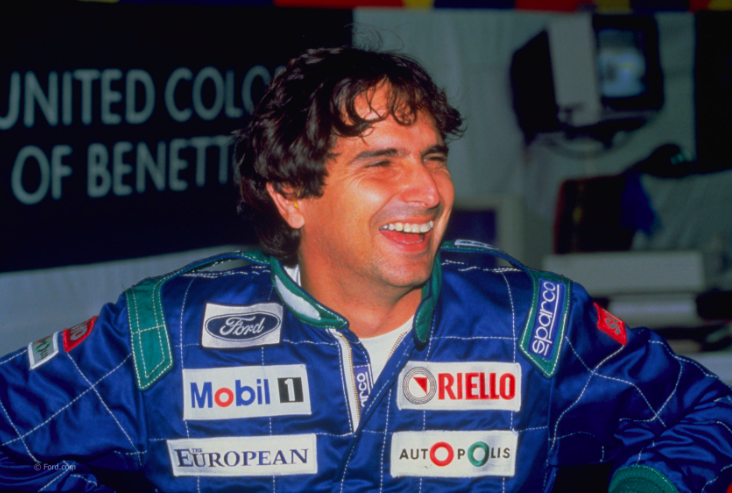
Nelson Piquet: The Brazilian Triple Crown Champion of Formula 1
Nelson Piquet, a name synonymous with brilliance and technical mastery in the world of Formula 1, etched his legacy in the annals of motorsport history by clinching three World Championships. With an astute strategic mind and an unparalleled ability to adapt to different teams and cars, Piquet’s career serves as a testament to the power of ingenuity, determination, and sheer racing acumen.
The Early Years: A Foundation of Passion and Determination
Humble Beginnings and Early Influences
Born on August 17, 1952, in Rio de Janeiro, Brazil, Nelson Piquet Souto Maior was destined to carve his path in racing. Unlike many of his contemporaries, Piquet did not come from a motorsport family. His father, Estácio Souto Maior, was a prominent politician, and his initial foray into motorsport faced significant parental opposition. Nevertheless, Piquet’s unwavering passion for racing saw him taking clandestine steps towards his dream.
Karting: The Breeding Ground of Talent
Piquet’s journey into the world of racing began in the karting circuits of Brazil. His natural talent quickly shone through as he dominated the local karting scene, clinching multiple championships. Karting was not merely a stepping stone for Piquet; it was where he honed his technical skills, understanding the nuances of vehicle dynamics and racecraft.
Rising Through the Ranks: From Formula 3 to Formula 1
The Leap to Europe: Formula 3 Success
In the 1970s, Piquet took his burgeoning talent to Europe, the epicenter of competitive motorsport. Competing in the British Formula 3 Championship, he swiftly made his mark by winning the 1978 championship. This success was pivotal, catching the eye of Formula 1 team owners and setting the stage for his entry into the pinnacle of motorsport.
Debut in Formula 1: Learning the Ropes
Piquet’s Formula 1 debut came with Ensign in 1978, but it was his subsequent move to Brabham that proved transformative. Under the tutelage of team owner Bernie Ecclestone and renowned designer Gordon Murray, Piquet’s technical acumen flourished. His ability to provide detailed feedback and contribute to car development became a hallmark of his career.
The First Championship: 1981
Technological Innovations and Strategic Mastery
The 1981 season saw Piquet clinch his first World Championship. Driving the Brabham BT49C, equipped with innovative features like hydropneumatic suspension to bypass ride height regulations, Piquet’s strategic approach and adaptability were on full display. His victory in the season’s penultimate race in Canada secured him the championship, underscoring his tactical brilliance.
Key Races and Highlights
- San Marino Grand Prix: Piquet’s masterful drive in challenging wet conditions highlighted his skill and determination.
- British Grand Prix: A pivotal win at Silverstone showcased Piquet’s ability to dominate on diverse circuits.
The Second Championship: 1983
Turbocharged Triumph
The 1983 season marked the dawn of the turbo era in Formula 1, and Piquet, driving the Brabham-BMW BT52, adapted seamlessly. His partnership with BMW proved fruitful, with the turbocharged engine providing the necessary power and speed. Piquet’s technical input was crucial in optimizing the car’s performance, leading to his second World Championship.
Memorable Moments
- Brazilian Grand Prix: Winning his home race was a significant morale booster and set the tone for the season.
- Italian Grand Prix: Piquet’s strategic acumen was evident as he outmaneuvered rivals on the historic Monza circuit.
The Third Championship: 1987
Joining Williams: A New Chapter
In 1986, Piquet joined Williams, a team on the rise with a competitive package. The 1987 season was fiercely contested, with Piquet facing off against teammate Nigel Mansell. Despite a turbulent season marred by intra-team rivalry and a severe crash during practice at Imola, Piquet’s resilience and consistency paid off as he secured his third World Championship.
Key Races and Tactical Brilliance
- Hungarian Grand Prix: Piquet’s memorable overtaking maneuver on Ayrton Senna, dubbed the “Piquet Pass,” remains one of the sport’s most iconic moments.
- Japanese Grand Prix: His calculated approach ensured he amassed enough points to clinch the title.
Legacy Beyond Championships
Technical Innovator and Strategist
Piquet’s legacy extends beyond his three championships. Known for his technical knowledge, he was instrumental in car development and strategy. His contributions to aerodynamic advancements and turbo technology were pivotal in shaping the future of the sport.
Mentor and Influencer
Post-retirement, Piquet’s influence continued as he mentored young drivers, including his son, Nelson Piquet Jr., who also pursued a career in motorsport. Piquet’s insights and experiences have been invaluable to the new generation of racers.
Personal Life and Off-Track Ventures
Family and Personal Interests
Piquet’s personal life has been as dynamic as his racing career. He is a father of seven, with children following diverse career paths, including motorsport and business. Piquet has also ventured into various business enterprises, leveraging his fame and acumen to build a successful post-racing career.
Business Ventures and Philanthropy
From automotive ventures to real estate, Piquet has demonstrated his business savvy. Additionally, his philanthropic efforts, particularly in supporting underprivileged youth in Brazil, reflect his commitment to giving back to the community.
The Modern Era: Reflections and Contributions
Commentator and Analyst
In recent years, Piquet has taken on roles as a commentator and analyst, sharing his wealth of knowledge with fans and providing insights into the evolving landscape of Formula 1. His candid and sometimes controversial opinions continue to spark discussions within the motorsport community.
Ambassador of the Sport
As an ambassador of Formula 1, Piquet’s presence at events and his engagement with fans underscore his enduring connection to the sport. His contributions to promoting motorsport, particularly in Brazil, have been instrumental in nurturing new talent and expanding the sport’s global reach.
Conclusion
Nelson Piquet’s illustrious career in Formula 1 is a testament to his technical brilliance, strategic mind, and unwavering determination. From his early days in karting to his three World Championships, Piquet’s journey is marked by resilience, adaptability, and a relentless pursuit of excellence.
His contributions to the sport extend beyond his on-track achievements, influencing car development, mentoring young talent, and promoting motorsport globally. As we reflect on his legacy, Nelson Piquet remains an enduring figure in the world of Formula 1, inspiring both fans and future champions.
Frequently Asked Questions (FAQs)
What made Nelson Piquet stand out in Formula 1?
Nelson Piquet’s technical knowledge, strategic approach, and adaptability made him a formidable competitor. His ability to work closely with engineers and provide detailed feedback for car development was a significant factor in his success.
How did Nelson Piquet’s early career in karting influence his Formula 1 success?
Karting provided Piquet with a strong foundation in racing, allowing him to hone his skills and develop a deep understanding of vehicle dynamics. This early experience was crucial in shaping his technical acumen and racecraft.
What were Nelson Piquet’s most memorable races?
Piquet’s career is filled with memorable races, including his victories at the San Marino Grand Prix in 1981, the Brazilian Grand Prix in 1983, and his iconic overtaking maneuver at the Hungarian Grand Prix in 1987.
How did Nelson Piquet contribute to the development of turbo technology in Formula 1?
Piquet played a pivotal role in the development of turbo technology, particularly during his time with Brabham and BMW. His technical feedback and strategic insights were instrumental in optimizing the performance of turbocharged engines.
What is Nelson Piquet’s legacy in Formula 1?
Nelson Piquet’s legacy in Formula 1 is defined by his three World Championships, his technical contributions to car development, and his role as a mentor and ambassador of the sport. His influence continues to be felt in the motorsport community, inspiring new generations of racers.
Motor Racing
The NASCAR Cup Series Championship: The Ultimate Guide to Stock Car Racing
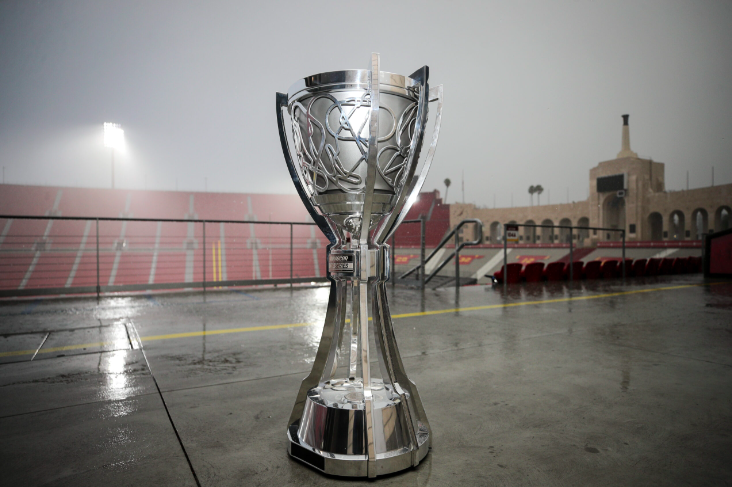
The NASCAR Cup Series Championship: The Ultimate Guide to Stock Car Racing
The NASCAR Cup Series Championship stands as the zenith of stock car racing, embodying the excitement, strategy, and sheer endurance of the sport. This ultimate showdown, where the best drivers battle for supremacy, captivates millions of fans every year.
In this detailed guide, we’ll explore every facet of the NASCAR Cup Series Championship, from its historical roots to the modern-day spectacle, ensuring that you gain a deep understanding of this thrilling competition.
Introduction to the NASCAR Cup Series Championship
The NASCAR Cup Series Championship represents the climax of the NASCAR Cup Series season, where the top drivers vie for the prestigious title. This high-octane event is more than just a race; it’s a culmination of a year-long battle of speed, strategy, and resilience.
What Is the NASCAR Cup Series Championship?
The NASCAR Cup Series Championship is the final race of the NASCAR Cup Series season. It determines the champion based on points accumulated throughout the year, culminating in a single race where the top contenders compete for the title. The championship race is the ultimate test of a driver’s skill and endurance, showcasing the best of stock car racing.
History and Evolution of the NASCAR Cup Series Championship
The NASCAR Cup Series Championship has a rich history that dates back to the inception of NASCAR in 1949. Over the decades, the format, rules, and prestige of the championship have evolved, reflecting the growth and changes within the sport.
Format and Structure of the Championship
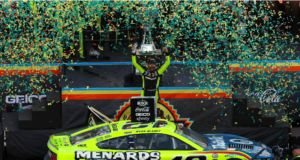
The Playoff System
The NASCAR Cup Series employs a playoff system to determine its champion. This system, introduced in 2004, adds a layer of excitement and competition. The playoffs consist of several rounds:
- Round of 16: The top 16 drivers based on regular-season points qualify for the playoffs. They compete in the first three races to advance to the next round.
- Round of 12: The top 12 drivers proceed to this round. Their goal is to accumulate enough points to advance to the next stage.
- Round of 8: The field narrows to the top 8 drivers. This round is crucial as it determines who will compete in the championship race.
- Championship 4: The final four drivers compete in the last race of the season. The highest finisher among these drivers is crowned the NASCAR Cup Series Champion.
Qualifying for the Championship
Qualifying for the NASCAR Cup Series Championship involves a rigorous process. Drivers must perform exceptionally well throughout the season to secure a spot in the playoffs. Success in qualifying races, regular-season points, and stage wins all contribute to a driver’s chance of advancing.
Notable Drivers and Teams
Historic Figures
The NASCAR Cup Series has seen many legendary drivers who have left an indelible mark on the sport. Drivers like Richard Petty, Dale Earnhardt, and Jeff Gordon have set numerous records and are celebrated for their achievements in the championship.
Current Contenders
In recent years, drivers such as Kyle Larson, Chase Elliott, and Denny Hamlin have become prominent figures in the NASCAR Cup Series Championship. Their skill and competitive spirit continue to shape the landscape of the sport.
The Impact of Technology on the Championship
Advancements in Car Technology
Technology plays a crucial role in modern stock car racing. From advanced aerodynamics to cutting-edge engines, technological innovations have significantly impacted the performance and safety of NASCAR vehicles.
Data Analytics and Strategy
Teams use data analytics to gain a competitive edge. By analyzing data from previous races and simulations, teams can make informed decisions about strategy, pit stops, and adjustments during races.
Fan Engagement and Media Coverage
The Role of Media
Media coverage enhances the NASCAR Cup Series Championship experience for fans. Television broadcasts, online streaming, and social media provide comprehensive coverage, bringing the excitement of the race to millions of viewers worldwide.
Fan Interaction
Fan engagement is a vital aspect of the NASCAR Cup Series Championship. Events, fan zones, and interactive experiences allow fans to connect with drivers and teams, deepening their connection to the sport.
The Economic Impact of the NASCAR Cup Series Championship
Revenue Generation
The NASCAR Cup Series Championship generates substantial revenue through ticket sales, sponsorships, and merchandising. This economic impact extends to local communities, benefiting businesses and tourism.
Sponsorship Deals
Sponsorships play a significant role in the NASCAR Cup Series. Companies invest in the sport to gain visibility and promote their brands, contributing to the overall success of the championship.
Challenges and Controversies
On-Track Challenges
The NASCAR Cup Series Championship faces various on-track challenges, including weather conditions, track incidents, and mechanical failures. These factors can significantly influence the outcome of races and the championship.
Controversies and Disputes
Controversies and disputes are part of the sport’s history. Disagreements over rules, penalties, and race outcomes often spark debates among fans and teams, adding to the drama of the championship.
Looking Ahead: The Future of the NASCAR Cup Series Championship
Evolving Formats
The NASCAR Cup Series Championship continues to evolve. Future changes in race formats, rules, and technology will shape the championship and ensure its relevance in the ever-changing landscape of motorsports.
Growing the Sport
Efforts to grow the sport include expanding international reach, attracting new fans, and enhancing the overall racing experience. The future of the NASCAR Cup Series Championship promises exciting developments and continued growth.
Conclusion
The NASCAR Cup Series Championship represents the pinnacle of stock car racing, showcasing the best drivers, teams, and technology in the sport. Its rich history, evolving formats, and significant impact on fans and the economy make it a captivating and dynamic event. As the championship continues to evolve, it remains a symbol of excellence and excitement in motorsports.
Frequently Asked Questions (FAQs)
What is the NASCAR Cup Series Championship?
The NASCAR Cup Series Championship is the final race of the NASCAR Cup Series season, determining the champion based on points accumulated throughout the year.
How are drivers selected for the NASCAR Cup Series Championship?
Drivers qualify for the championship through a playoff system, which includes several rounds leading up to the final race where the top contenders compete for the title.
Who are some of the most famous drivers in NASCAR Cup Series history?
Notable drivers include Richard Petty, Dale Earnhardt, and Jeff Gordon, who have set numerous records and are celebrated for their achievements.
How has technology impacted the NASCAR Cup Series Championship?
Advancements in car technology and data analytics have significantly improved performance, safety, and strategy in the NASCAR Cup Series Championship.
What are some challenges faced in the NASCAR Cup Series Championship?
Challenges include weather conditions, track incidents, and mechanical failures, which can influence the outcome of races and the championship.
For more detailed insights into the NASCAR Cup Series Championship, check out NASCAR’s official site and NASCAR Cup Series history.
Motor Racing
The Indianapolis 500 Trophy: A Symbol of Racing Excellence
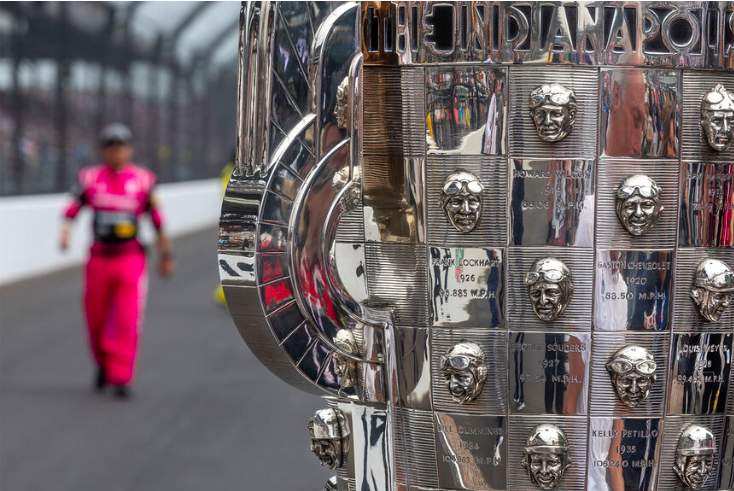
The Indianapolis 500 Trophy: A Symbol of Racing Excellence
The Indianapolis 500 Trophy stands as a testament to the legacy and prestige of one of the most celebrated motorsport events in history. Known officially as the Borg-Warner Trophy, this iconic award is not merely a symbol of victory but a piece of art that encapsulates the triumph, dedication, and skill of its champions.
Since its introduction in 1936, the trophy has become an enduring emblem of the Indianapolis 500, celebrating the achievements of drivers who have conquered the “Greatest Spectacle in Racing.” With its intricate design, historical significance, and cultural impact, the Indianapolis 500 Trophy remains a revered artifact in the world of racing.
History of the Indianapolis 500 Trophy
Origins and Early Years
The Indianapolis 500, also known as “The Greatest Spectacle in Racing,” first took place in 1911. The race quickly became a cornerstone of American motorsports, drawing competitors from around the globe. The trophy, however, was introduced much later.
Introduction of the Trophy
The Borg-Warner Trophy was commissioned in 1935, reflecting the prestige of winning the Indianapolis 500. It was designed to be a timeless representation of victory and skill, capturing the essence of the race itself. The trophy was first awarded to Louis Meyer, a three-time winner of the Indianapolis 500, in 1936.
Significant Changes Over the Decades
Throughout its history, the Indianapolis 500 Trophy has seen several updates and modifications, but its core design and significance have remained unchanged. These changes reflect the evolving nature of the sport and the continuous efforts to honor the legacy of the Indianapolis 500.
Design and Craftsmanship
Materials Used
The Borg-Warner Trophy is made primarily of sterling silver, standing over 5 feet tall and weighing approximately 110 pounds. The use of sterling silver not only ensures its durability but also adds a touch of elegance and grandeur befitting such a prestigious award.
Artistry and Details
One of the most striking features of the Indianapolis 500 Trophy is the inclusion of a bas-relief sculpture of every winner’s face, meticulously crafted to capture their likeness. These sculptures are added annually, celebrating each new champion while maintaining a connection to the past.
The Iconic Winged Victory
At the top of the trophy sits a representation of the ancient Greek goddess Nike, symbolizing victory. This figure, known as the “Winged Victory,” adds a mythological element to the trophy, underscoring the monumental achievement of winning the Indianapolis 500.
The Legacy of Winners
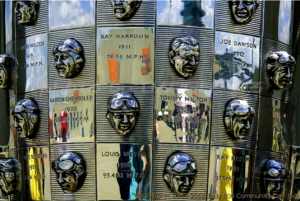
Notable Winners
Over the years, many legendary drivers have etched their names and faces into the history of the Indianapolis 500 Trophy. Icons like A.J. Foyt, Al Unser, and Rick Mears, who each have multiple wins, have become synonymous with the race itself.
Modern-Day Champions
In recent years, drivers such as Helio Castroneves and Scott Dixon have continued to add to the rich legacy of the trophy. Their victories are celebrated not only for their individual skill but also for their contributions to the ongoing story of the Indianapolis 500.
The Trophy’s Journey
On Display
The Indianapolis 500 Trophy is housed at the Indianapolis Motor Speedway Museum when not in use. This allows fans to get up close to a piece of racing history, experiencing the trophy’s magnificence firsthand.
Traveling Trophy
Occasionally, the trophy travels to various events and locations, allowing a wider audience to appreciate its significance. These appearances help maintain the connection between the trophy, the race, and the global motorsport community.
Technological Advances and the Trophy
Evolution of Car Design
As car design and technology have evolved, so too has the significance of the Indianapolis 500 Trophy. Modern cars are faster, safer, and more technologically advanced than ever, making the achievement of winning the race even more impressive.
Impact of Safety Innovations
Safety innovations have transformed the sport, reducing the risk for drivers while maintaining the excitement and challenge of the race. These advancements ensure that each new winner of the trophy has overcome significant challenges to earn their victory.
The Cultural Impact of the Indianapolis 500 Trophy
In Pop Culture
The Indianapolis 500 Trophy has appeared in various forms of media, from movies to documentaries, highlighting its iconic status. Its presence in pop culture reinforces its significance beyond the realm of motorsports.
Fan Engagement
Fans of the Indianapolis 500 form a passionate community, and the trophy is a central figure in their celebrations. From viewing parties to merchandise, the trophy’s image is a beloved symbol for racing enthusiasts worldwide.
Sponsorship and Commercial Influence

Corporate Partnerships
The sponsorship and commercial influence surrounding the Indianapolis 500 Trophy have grown significantly. Corporate partnerships help fund the race and the maintenance of the trophy, ensuring its continued prominence.
Marketing and Branding
The trophy serves as a powerful marketing tool, representing excellence and the pinnacle of achievement. Brands associated with the trophy benefit from its prestigious image, aligning themselves with its legacy of success.
Future of the Indianapolis 500 Trophy
Sustainability and Innovation
As motorsports look toward a sustainable future, the Indianapolis 500 Trophy remains a symbol of innovation. Efforts to reduce the environmental impact of racing will ensure that the trophy continues to represent the cutting edge of technology and performance.
Preserving the Tradition
While embracing change, it is equally important to preserve the traditions that make the Indianapolis 500 and its trophy unique. This balance will ensure that the trophy remains a cherished icon for generations to come.
Conclusion
The Indianapolis 500 Trophy is not just an award; it is a testament to the skill, determination, and passion of the drivers who compete for it. Its rich history, intricate design, and cultural significance make it one of the most prestigious trophies in motorsport. As we look to the future, the trophy will continue to inspire and symbolize the pinnacle of racing excellence.
Frequently Asked Questions (FAQs)
What makes the Indianapolis 500 Trophy unique?
The Indianapolis 500 Trophy is unique due to its detailed craftsmanship, including the bas-relief sculptures of every winner’s face, and its storied history. The use of sterling silver and the iconic Winged Victory figure further enhance its uniqueness.
How is the winner’s face added to the trophy?
Each winner’s face is sculpted in bas-relief and then attached to the trophy. This process involves precise artistry to ensure an accurate likeness, adding to the trophy’s historical significance.
Where can fans see the Indianapolis 500 Trophy?
The trophy is typically displayed at the Indianapolis Motor Speedway Museum, allowing fans to view it up close. It also travels to various events, making appearances to engage with a broader audience.
How has the Indianapolis 500 Trophy evolved over the years?
While the core design has remained consistent, the trophy has seen updates to accommodate new winners and reflect the evolving nature of the sport. These changes ensure it remains relevant and prestigious.
What role does the trophy play in motorsport culture?
The Indianapolis 500 Trophy plays a central role in motorsport culture as a symbol of ultimate achievement. Its presence in media and fan celebrations highlights its importance beyond the racetrack.
For more information about the Indianapolis 500 Trophy, visit the official Indianapolis Motor Speedway website.
Motor Racing
The Formula 1 World Championship: A Comprehensive Guide
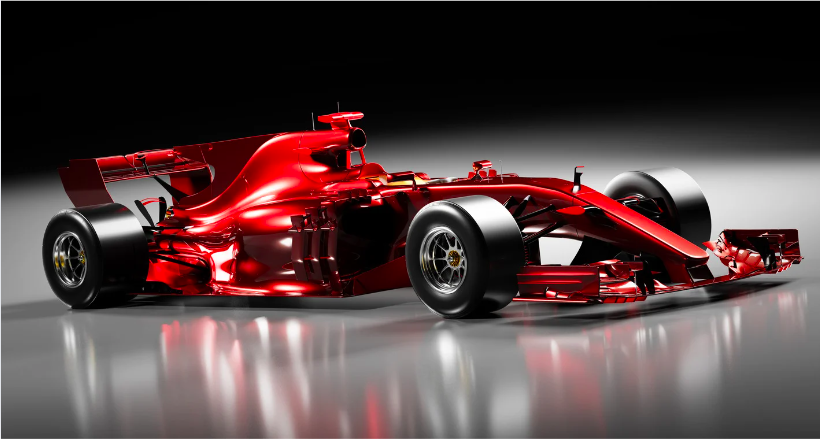
The Formula 1 World Championship: A Comprehensive Guide
The Formula 1 World Championship stands as the pinnacle of motorsport, captivating millions of fans worldwide with its blend of cutting-edge technology, intense competition, and iconic races. As we dive into the rich history, technical intricacies, and the unparalleled excitement of F1, you’ll discover why it remains a premier global sporting event.
History of Formula 1

The Inception of Formula 1
The origins of Formula 1 trace back to the post-World War II era, with the first official championship held in 1950. The race took place at Silverstone in the United Kingdom, marking the beginning of a new era in motorsport. Giuseppe Farina won the inaugural championship driving for Alfa Romeo, setting the stage for a legacy of speed and innovation.
Evolution Over the Decades
The 1950s and 60s saw rapid developments in both car technology and race regulations. Teams like Ferrari, Mercedes, and Lotus became household names. The era was characterized by both triumphs and tragedies, as the sport’s inherent dangers led to numerous fatalities, prompting significant safety improvements.
Modern Era and Technological Advancements
From the 1980s onward, Formula 1 embraced advanced technology, leading to the introduction of turbocharged engines, complex aerodynamics, and electronic driver aids. This period also saw the rise of legendary drivers like Ayrton Senna, Alain Prost, and Michael Schumacher, who dominated the sport and became global icons.
Understanding the Formula 1 Cars
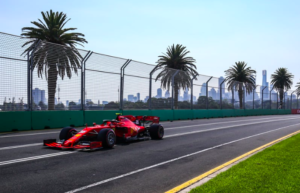
Chassis and Aerodynamics
The chassis forms the backbone of an F1 car, designed to be both lightweight and strong. Made primarily from carbon fiber composites, the chassis must withstand immense forces while providing optimal driver protection. Aerodynamics play a crucial role, with every surface of the car engineered to maximize downforce and minimize drag.
Power Units
Modern F1 cars are powered by hybrid engines, combining a traditional internal combustion engine with an electric motor. This combination not only delivers incredible power but also improves fuel efficiency. The power units are a marvel of engineering, capable of producing over 1000 horsepower.
Tires and Braking Systems
Tires are the only contact point between the car and the track, making them vital for performance. Pirelli supplies all F1 teams with specific compounds designed for varying conditions. The braking systems, made from carbon-carbon materials, provide the immense stopping power required to control the high speeds.
The Structure of a Formula 1 Season
The Race Calendar
A typical F1 season consists of around 20-23 races, known as Grands Prix, held across various continents. Each race weekend follows a standard format, including practice sessions, qualifying, and the main race on Sunday. Iconic circuits like Monaco, Silverstone, and Monza are staples on the calendar.
Points System and Championships
Points are awarded to the top 10 finishers in each race, with the winner receiving 25 points. These points contribute to both the Drivers’ and Constructors’ Championships. The driver and team with the most points at the end of the season are crowned champions.
Qualifying Sessions
Qualifying determines the starting grid for the race. It consists of three sessions (Q1, Q2, and Q3), with the slowest drivers being eliminated in each round. The final session, Q3, decides the top 10 grid positions.
The Teams and Drivers
Top Teams in Formula 1
- Mercedes-AMG Petronas Formula One Team: Dominant in recent years, with multiple championships.
- Scuderia Ferrari: The oldest and most successful team in F1 history.
- Red Bull Racing: Known for their innovative designs and competitive edge.
- McLaren: A historic team with a resurgence in recent seasons.
Legendary Drivers
- Lewis Hamilton: Seven-time world champion known for his exceptional skill and consistency.
- Michael Schumacher: Holds the record for the most championships, with seven titles.
- Ayrton Senna: Remembered for his raw talent and tragic death.
- Sebastian Vettel: Four-time world champion with Red Bull Racing.
The Business of Formula 1
Sponsorship and Advertising
Sponsorship plays a crucial role in F1, with brands eager to associate with the sport’s glamour and global reach. Teams sport logos from a wide array of industries, from technology to fashion.
Broadcasting and Media Rights
Television rights are a significant revenue stream for F1. The sport has embraced digital media, with platforms like F1 TV offering live streaming and exclusive content to fans worldwide.
Economic Impact on Host Cities
Hosting a Grand Prix can boost a city’s economy through tourism and global exposure. Iconic races like the Monaco Grand Prix and the Singapore Grand Prix are renowned for their spectacle and economic benefits.
Technological Innovations in Formula 1
Data and Telemetry
Data analysis is integral to F1, with teams collecting vast amounts of data from their cars in real time. Telemetry systems monitor every aspect of the car’s performance, providing engineers with the information needed to optimize speed and reliability.
Wind Tunnels and Simulators
Wind tunnels are used to test and refine aerodynamics, while simulators allow drivers to practice and engineers to experiment with setups without physical track time. These tools are essential for developing competitive cars.
Hybrid Power Units
The introduction of hybrid power units marked a significant technological leap in Formula 1. These units consist of an internal combustion engine (ICE) paired with an Energy Recovery System (ERS), which recovers energy from braking and heat. This combination enhances fuel efficiency and provides a power boost, demonstrating F1’s commitment to sustainable innovation.
Advanced Materials
Formula 1 cars utilize advanced materials like carbon fiber for the chassis and aerodynamic components, ensuring maximum strength and minimal weight. Innovations in materials science allow teams to push the boundaries of performance while maintaining safety standards.
The Race Weekend
Practice Sessions
A typical race weekend begins with three practice sessions. These sessions allow teams to fine-tune their car setups, test new parts, and gather data under various track conditions. Practice sessions are crucial for developing race strategies and understanding tire behavior.
Qualifying
Qualifying is split into three segments: Q1, Q2, and Q3. In Q1, all drivers compete, with the slowest five eliminated. Q2 follows the same format, narrowing the field further. Q3 features the fastest ten drivers battling for the top grid positions. Qualifying is intense, often decided by fractions of a second.
The Race
Race day is the climax of the weekend. Drivers line up on the grid according to their qualifying positions. The race involves a combination of speed, strategy, and endurance, with pit stops playing a critical role. Teams must balance tire wear, fuel loads, and track conditions to optimize performance.
Strategies in Formula 1
Tire Management
Tire strategy is paramount in F1. Teams choose from different compounds provided by Pirelli, each offering a trade-off between speed and durability. Managing tire wear and selecting the right compound at the right time can make or break a race.
Pit Stops
Pit stops are strategic moments where teams change tires and make adjustments. A well-executed pit stop can gain precious seconds, while mistakes can be costly. Teams practice relentlessly to achieve seamless pit stops, often lasting under three seconds.
Fuel Strategy
Fuel management is crucial, especially with the introduction of fuel flow limits. Teams must ensure they have enough fuel to finish the race while minimizing weight. Engineers use sophisticated software to plan fuel loads and consumption rates.
Iconic Formula 1 Circuits
Monaco Grand Prix
The Monaco Grand Prix is the jewel in the F1 crown. The tight and twisty streets of Monte Carlo provide a unique challenge, with little margin for error. The glitz and glamour of Monaco attract celebrities and fans alike, making it one of the most prestigious races on the calendar.
Silverstone Circuit
Silverstone, the birthplace of F1, is a fast and flowing circuit in the UK. Its rich history and passionate fans make it a highlight of the season. The track’s high-speed corners and unpredictable weather often lead to thrilling races.
Suzuka International Racing Course
Suzuka in Japan is known for its figure-eight layout and technical challenges. The track tests both car and driver with a mix of high-speed straights and tight corners. Suzuka has hosted many memorable races and is a favorite among drivers.
Safety in Formula 1
Car Safety Features
Modern F1 cars are equipped with advanced safety features, including the Halo device, which protects drivers’ heads from debris. The carbon fiber monocoque chassis is incredibly strong, designed to absorb impact and protect the driver in a crash.
Track Safety
Tracks are equipped with extensive safety measures, including TecPro barriers, gravel traps, and runoff areas. The FIA continuously evaluates and updates safety standards to reduce the risk of accidents.
Medical Support
F1 races have dedicated medical teams and facilities. The medical car follows the field on the first lap, ready to respond immediately to any incidents. Additionally, the FIA requires regular medical checks for drivers to ensure they are fit to race.
Environmental Impact and Sustainability
Sustainable Initiatives
Formula 1 is committed to reducing its environmental impact. Initiatives include the use of hybrid power units, sustainable fuels, and a push towards carbon neutrality by 2030. The sport is also exploring new technologies to reduce emissions and improve energy efficiency.
Recycling and Waste Reduction
Teams are increasingly focusing on recycling and waste reduction. From car components to hospitality, F1 aims to minimize its environmental footprint. Innovative recycling programs and sustainable practices are becoming standard.
Future of F1
The future of F1 involves further advancements in sustainable technology. The sport is exploring fully electric power units, sustainable materials, and eco-friendly logistics. These efforts will ensure F1 remains a leader in both entertainment and innovation.
The Fan Experience
Attending a Grand Prix
Attending a Grand Prix is a thrilling experience. Fans can enjoy a range of activities, from pit lane walks to fan zones. The atmosphere is electric, with the roar of the engines and the excitement of the crowd creating unforgettable memories.
F1 Merchandise
F1 merchandise allows fans to show their support for their favorite teams and drivers. From apparel to collectibles, official merchandise is a significant part of the fan experience. Online stores and trackside shops offer a wide variety of products.
Virtual and Augmented Reality
Virtual and augmented reality technologies are enhancing the fan experience. Fans can enjoy immersive experiences, from virtual track tours to live race data overlays. These innovations bring fans closer to the action than ever before.
Conclusion
The Formula 1 World Championship is more than just a sport; it’s a blend of passion, technology, and tradition. With its rich history, cutting-edge innovations, and global appeal, F1 continues to captivate audiences around the world. Whether you’re a long-time fan or new to the sport, the excitement of Formula 1 is undeniable. As the sport evolves, it promises to deliver even more thrilling moments and technological advancements, solidifying its place as the pinnacle of motorsport.
Frequently Asked Questions (FAQs)
What is the significance of the Halo device in Formula 1?
The Halo device is a safety feature introduced in 2018 to protect drivers from flying debris and impacts. It is a titanium structure that surrounds the driver’s cockpit, significantly reducing the risk of head injuries.
How do teams decide on their tire strategy for a race?
Teams analyze data from practice sessions and previous races to determine the best tire strategy. Factors include tire wear rates, track temperature, and expected weather conditions. The goal is to balance speed with durability to optimize performance.
Why is the Monaco Grand Prix considered special?
The Monaco Grand Prix is special due to its historic significance, challenging street circuit, and glamorous setting. The race is a favorite among drivers and fans, offering a unique spectacle with its tight corners and iconic landmarks.
How has technology improved safety in Formula 1?
Technology has significantly improved safety in F1 through advanced car designs, robust track safety measures, and real-time monitoring systems. Innovations like the Halo device, improved crash barriers, and enhanced medical support have made the sport safer for drivers and spectators.
What are hybrid power units, and how do they work in F1 cars?
Hybrid power units in F1 combine an internal combustion engine with an Energy Recovery System (ERS). The ERS recovers energy from braking and heat, converting it into electrical power. This system improves fuel efficiency and provides a power boost, showcasing F1’s commitment to sustainable technology.
For more information and updates on Formula 1, visit the official Formula 1 website.
-

 NBA4 months ago
NBA4 months agoLaMelo Ball Net Worth: A Comprehensive Look at the NBA Star’s Financial Empire
-

 Football5 months ago
Football5 months agoMeet the World Football Celebrities and Their Stories
-

 Football4 months ago
Football4 months agoEuro 2024: Alvaro Morata Speaks Out About ‘No Respect’ in Spain
-

 Game5 months ago
Game5 months agoThe Ultimate Guide to General Multi-Sport Events
-

 Football4 months ago
Football4 months agoEuro 2024 Power Rankings: Spain Remains Dominant Ahead of Semifinals
-

 Football4 months ago
Football4 months agoRonaldo’s Business Ventures and Investments (CR7 Brand)
-

 NBA5 months ago
NBA5 months agoTop NBA Celebrities in the World: The Biggest Stars
-

 Sports6 months ago
Sports6 months agoPele: The Legendary Journey of Football’s Greatest Icon | The Immortal King of Football




